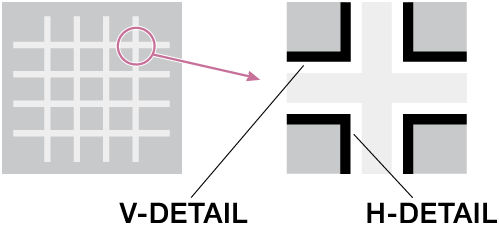Emphasizing image edges (Detail)
Available Picture Profile setting items and options may vary depending on camera specifications.
This function adjusts how much detail is applied to the subject’s image edges.
Because settings other than [Level] are quite complex, we recommend you start by adjusting only the [Level] setting first.
| Parameters | Settings |
|---|---|
| Detail > Level | –7 (Weak) to +7 (Strong) |
| Detail > Adjust > Mode | Auto / Manual |
| Detail > Adjust > V/H Balance | –2 (Stronger Vertical (V) detail) to +2 (Stronger Horizontal (H) detail) |
| Detail > Adjust > B/W Balance | Type1 (Higher proportion of black detail) to Type5 (Higher proportion of white detail) |
| Detail > Adjust > Limit | 0 (Strongly restricted) to 7 (No restriction) |
| Detail > Adjust > Crispening | 0 (No restriction) to 7 (Strongly restricted) |
| Detail > Adjust > Hi-Light Detail | 0 (Smaller detail amount) to 4 (Larger detail amount) |
Level
This function determines the strength of detail image processing to be applied.
- If you apply too much detail, the subject’s original atmosphere may be undermined, as its translucence may be lost or it may be given an unnatural luster. Excessive detail when shooting shiny leaves, for instance, may result in the leaves looking as if they are made of plastic. It is also advisable to apply detail only modestly when shooting paintings.
- Because Detail makes image edges wider, the original texture of a subject consisting of very fine lines may be lost if too much detail processing is applied. (Example: thin lace curtains)
- Also, be aware that Detail may fatten up the edges of noise particles that appear under a high gain setting, and may make such particles highly noticeable. In such cases, you can adjust the amount of detail processing on the noise particles by using the [Crispening] function.
- The image edges become more visible when viewed on large screens. It may be advisable to ease off on Detail if you plan to view the image on large TVs or screens.

Detail: –

Detail: +
Mode
If you want to make finer adjustments to detail, set [Mode] in [Adjust] to [Manual] and adjust the following settings.
V/H Balance
This function regulates the balance between Vertical (V) detail and Horizontal (H) detail. Vertical (V) detail boosts image edges by expanding them upward and downward. Horizontal (H) detail emphasizes image outlines by thickening them to the left and right.
- The results of detail processing may appear differently depending on the TV, computer display or other type of display monitor. Adjust [V/H Balance] as needed.
- To emphasize the impression of a subject that has many horizontal elements, such as a human face (with eyes and mouth), you can increase the proportion of Vertical (V) detail by lowering the setting (selecting a lower set value).

B/W Balance
This function changes the balance between the amount of black detail for low-luminance areas and the amount of white detail for high-luminance areas.

Limit
This function restricts the amount of black detail for low-luminance areas and white detail for high-luminance areas by setting a maximum value. The maximum value cannot be set independently for black detail and white detail.
- [B/W Balance] and [Limit] adjust the amount of black detail and white detail added to image edges.
- Black detail adds the impressions of “power,” “hardness,” and “presence” to the subject. But it may bring undesirable effects because it emphasizes wrinkles and pores.
- White detail gives the subject a “clean” and “glossy” impression. You can increase the proportion of white detail and reduce that of black detail when shooting jewelry and glass objects to heighten their clarity and translucence.

Crispening
This function reduces detail that accompanies visual noise to prevent noise from being emphasized.
You can use this function when you want to apply detail processing to the subject while keeping noise as unnoticeable as possible.
Hi-Light Detail
This function adjusts the detail level for bright subjects.
You can use this to emphasize the edges of a bright subject in front of a high-luminance background.

